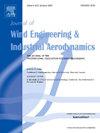Flow-induced vibration and force characteristics of a downstream cylinder with two degrees of freedom influenced by upstream cylinder wake
IF 4.9
2区 工程技术
Q1 ENGINEERING, CIVIL
Journal of Wind Engineering and Industrial Aerodynamics
Pub Date : 2025-07-08
DOI:10.1016/j.jweia.2025.106163
引用次数: 0
Abstract
A study on 2-DOF vibration characteristics and aerodynamic forces of a downstream cylinder in staggered arrangements is conducted, with cylinder center spacings of L/D = 2.5–6.0 longitudinally and T/D = −2–0 transversely (where L and T denote longitudinal and transverse spacings, D denotes cylinder diameter). The investigation covers reduced velocities (Ur = U/(fnD)) from 12.5 to 72.1, where U is wind speed and fn is natural frequency. Three distinct vibration forms are observed: Wake-Induced Vibration (WIV), Wake-Induced Flutter (WIF), and horizontal vibration induced by the laminar separation and turbulent reattachment (LSTR) flow pattern at inner lift peak positions, termed LHV. For WIV, tandem arrangements yield predominantly vertical oscillations with peak amplitudes reaching 1.83D, whereas staggered arrangements produce comparable horizontal and vertical responses at higher wind speeds. WIF characteristics include rapid amplitude growth and frequency reduction with increasing wind speed. Under the staggered arrangement of (2.5, −0.4), two distinct horizontal vibration regions emerge, driven by inner shear layer oscillation frequency lock-in and flow separation-reattachment, respectively. Force measurements during oscillation indicate unsteady characteristics in tandem arrangements but quasi-steady features in staggered cases. Additionally, consistent force-displacement phase differences observed in WIV under staggered arrangements provide valuable experimental data for future theoretical model development and validation.
受上游尾迹影响的二自由度下游圆柱体流激振动及力特性
研究了纵向圆柱中心间距L/D = 2.5 ~ 6.0,横向圆柱中心间距T/D =−2 ~ 0(其中L和T分别表示纵向和横向间距,D表示圆柱直径)的交错排列下游圆柱的二自由度振动特性和气动力。调查涵盖了从12.5到72.1的降低速度(Ur = U/(fnD)),其中U为风速,fn为固有频率。观察到三种不同的振动形式:尾迹诱导振动(WIV)、尾迹诱导颤振(WIF)和由内升力峰值位置层流分离和湍流再附着(LSTR)流型引起的水平振动,称为LHV。对于WIV,串联排列主要产生垂直振荡,峰值振幅达到1.83 3d,而交错排列在更高风速下产生相当的水平和垂直响应。WIF的特征包括振幅快速增长和频率随风速增加而降低。在(2.5,−0.4)交错布置下,在剪切层振荡频率锁定和流动分离-再附着驱动下,出现了两个明显的水平振动区。振动过程中的力测量表明,串列排列具有非定常特征,而交错排列具有准定常特征。此外,交错排列WIV中观察到的一致的力-位移相位差为未来理论模型的开发和验证提供了有价值的实验数据。
本文章由计算机程序翻译,如有差异,请以英文原文为准。
求助全文
约1分钟内获得全文
求助全文
来源期刊
CiteScore
8.90
自引率
22.90%
发文量
306
审稿时长
4.4 months
期刊介绍:
The objective of the journal is to provide a means for the publication and interchange of information, on an international basis, on all those aspects of wind engineering that are included in the activities of the International Association for Wind Engineering http://www.iawe.org/. These are: social and economic impact of wind effects; wind characteristics and structure, local wind environments, wind loads and structural response, diffusion, pollutant dispersion and matter transport, wind effects on building heat loss and ventilation, wind effects on transport systems, aerodynamic aspects of wind energy generation, and codification of wind effects.
Papers on these subjects describing full-scale measurements, wind-tunnel simulation studies, computational or theoretical methods are published, as well as papers dealing with the development of techniques and apparatus for wind engineering experiments.

 求助内容:
求助内容: 应助结果提醒方式:
应助结果提醒方式:


